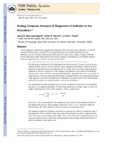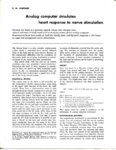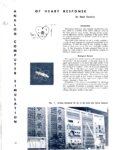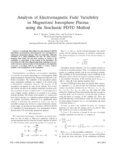Filters: Collection: "ir_uspace"
| Creator | Title | Description | Subject | Date | ||
|---|---|---|---|---|---|---|
| 526 |
 |
Carter, John B. | An O(1) time complexity software barrier | As network latency rapidly approaches thousands of processor cycles and multiprocessors systems become larger and larger, the primary factor in determining a barrier algorithm?s performance is the number of serialized network latencies it requires. All existing barrier algorithms require at least ... | Network latency; Barrier algorithm; Time complexity software barrier | 2004 |
| 527 |
 |
Henderson, Thomas C. | An O(n) time discrete relaxation architecture for real-time processing of the consistent labeling problem | Discrete relaxation techniques have proven useful in solving a wide range of problems in digital signal and digital image processing, artificial intelligence, operations research, and machine vision. Much work has been devoted to finding efficient hardware architectures. This paper shows that a conv... | Discrete relaxation techniques | 1986 |
| 528 |
 |
Mathews, V. John | An optimal design procedure for intraband vector quantized subband coding | AbstTact- Subband coding with vector quantization is addressed in this paper. Forming the data vectors from both between and within the subbands is considered. The former of these two schemes is referred to as interband coding and the latter as intraband coding. Interband coder design is relatively ... | 1995 | |
| 529 |
 |
Gu, Jun | An optimal, parallel discrete relaxation algorithm and architecture (Revised January 1988 and August 1989) | A variety of problems in artificial intelligence, operations research, symbolic logic, pattern recognition and computer vision, and robot manipulation are special cases of the Consistent Labeling Problem (CLP). The Discrete Relaxation Algorithm (DRA) is an efficient computational technique to enfor... | Consistent Labeling Problem; CLP; Discrete Relaxation Algorithm; DRA | 1988 |
| 530 |
 |
Parkinson, John Stansfield | An unorthodox sensory adaptation site in the E. coli serine chemoreceptor | The serine chemoreceptor of E. coli contains four canonical methylation sites for sensory adaptation that lie near inter-subunit helix interfaces of the Tsr homodimer. An unexplored fifth methylation site, E502, lies at an intra-subunit helix interface, closest to the HAMP domain that controls input... | 2014-01-01 | |
| 531 |
 |
Warner, Homer R. | Analog Computer Analysis of Dispersion of Indicator in the Circulation | Biomedical Informatics | 1966 | |
| 532 |
 |
Gardner, Reed M. | Analog Computer Simulates Heart Response to Nerve Stimulation | Biomedical Informatics | 1961 | |
| 533 |
 |
Gardner, Reed M. | Analog Computer Simulation of Heart Response | Biomedical Informatics | 1961 | |
| 534 |
 |
Harrison, Reid R.; Myers, Chris J.; Schlegel, Christian | Analog decoding of product codes | A design approach is presented for soft-decision decoding of block product codes ("block turbo codes") using analog computation with MOS devices. Application of analog decoding to large code sizes is also considered with the introduction of serial analog interfaces and pipeline schedules. | 2001-01-11 | |
| 535 |
 |
Myers, Chris J. | Analog decoding of product codes | A design approach is presented for soft-decision decoding of block product codes ("block turbo codes") using analog computation with MOS devices. Application of analog decoding to large code sizes is also considered with the introduction of serial analog interfaces and pipeline schedules. | 2001 | |
| 536 |
 |
Myers, Chris J.; Harrison, Reid R.; Schlegel, Christian | Analog decoding of product codes | Abstract - A method is presented for analog softdecision decoding of block product codes (block turbo codes). Extrinsic information is exchanged as analog signals between component row and column decoders. The component MAP decoders use low-power analog computation in subthreshold CMOS circuits t... | 2002 | |
| 537 |
 |
Harrison, Reid R.; Myers, Chris J.; Schlegel, Christian | Analog decoding of product codes | A method is presented for analog softdecision decoding of block product codes (block turbo codes). Extrinsic information is exchanged as analog signals between component row and column decoders. The component MAP decoders use low-power analog computation in subthreshold CMOS circuits to implement th... | 2002 | |
| 538 |
 |
Myers, Chris J.; Schlegel, Christian | Analog MAP decoder for (8, 4) hamming code in subthreshold CMOS | An all-MOS analog implementation of a MAP decoder is presented for the (8, 4) extended Hamming code. This paper describes the design and analysis of a tail-biting trellis decoder implementation using subthreshold CMOS devices. A VLSI test chip has recently returned from fabrication, and preliminary ... | 2001 | |
| 539 |
 |
Myers, Chris J.; Schlegel, Christian | Analog MAP decoder for (8, 4) hamming code in subthreshold CMOS | Abstract - An all-MOS analog tail-biting MAP decoder is presented for an (8,4) Hamming code. The decoder implements a probability propagation algorithm using subthreshold CMOS networks. Physical results verify the expected behavior of the decoderand demonstrate robustness of analog decoding circuit... | 2001 | |
| 540 |
 |
Harrison, Reid R. | Analog MAP decoder for (8,4) hamming code in subthreshold CMOS | An all-MOS analog tail-biting MAP decoder is presented for an (8,4) Hamming code. The decoder implements a probability propagation algorithm using subthreshold CMOS networks. Physical results verify the expected behavior of the decoder and demonstrate robustness of analog decoding circuits. | MAP decoder; Hamming code; VLSI | 2004-01-01 |
| 541 |
 |
Harrison, Reid R. | Analog VLSI implementation of a visual interneuron: enhanced sensory processing through biophysical modeling | Flies are capable of rapid, coordinated flight through unstructured environments. This flight is guided by visual motion information that is extracted from photoreceptors in a robust manner. One feature of the fly's visual processing that adds to this robustness is the saturation of wide-fi_x000... | 1999-01-01 | |
| 542 |
 |
Harrison, Reid R. | Analog VLSI model of the fly elementary motion detector | Flies are capable of rapidly detecting and integrating visual motion information in behaviorly-relevant ways. The first stage of visual motion processing in flies is a retinotopic array of functional units known as elementary motion detectors (EMDs). Several decades ago, Reichardt and colleagues de... | 1998-01-01 | |
| 543 |
 |
Riloff, Ellen M. | Analyses for elucidating current question answering technology | In this paper, we take a detailed look at the performance of components of an idealized question answering system on two diff erent tasks: the TREC Question Answering task and a set of reading comprehension exams. We carry out three types of analysis: inherent properties of the data, feature analys... | TREC Question Answering task | 2001-12 |
| 544 |
 |
Carter, John B. | Analysis of avalanche's shared memory architecture | In this paper, we describe the design of the Avalanche multiprocessor's shared memory subsystem, evaluate its performance, and discuss problems associated with using commodity workstations and network interconnects as the building blocks of a scalable shared memory multiprocessor. Compared to other ... | Avalanche multiprocessor; Shared memory | 1997 |
| 545 |
 |
Sperry, John S. | Analysis of circular bordered pit function I. Angiosperm vessels with homogenous pit membranes | A model predicted pit and vessel conductivity, the air-seed pressure for cavitation, and the implosion pressure causing vessel collapse. Predictions were based on measurements from 27 angiosperm species with circular bordered pits and air-seed pressures of 0.2-11.3 MPa. Vessel implosion pressure exc... | Functional wood anatomy; hydraulic architecture; plant biomechanics | 2004 |
| 546 |
 |
Sperry, John S. | Analysis of circular bordered pit function II. Gymnosperm tracheids with torus-margo pit membranes | A model of xylem conduit function was applied to gymnosperm tracheids with torus-margo pit membranes for comparison with angiosperm vessels. Tracheids from 17 gymnosperm tree species with circular bordered pits and air-seed pressures from 0.8 to 11.8 MPa were analyzed. Tracheids were more reinforced... | Functional wood anatomy; hydraulic architecture; plant biomechanics | 2004 |
| 547 |
 |
Gerig, Guido | Analysis of diffusion tensor imaging for subjects with Down Syndrome | Authors: Neda Sadeghi1, Clement Vachet1, Marcel Prastawa1, Julie Korenberg1, Guido Gerig1 Institutions: 1University of Utah, Salt Lake City, UT Introduction: Down syndrome (DS) is the most common chromosome abnormality in humans. It is typically associated with delayed cognitive development and phys... | 2013-01-01 | |
| 548 |
 |
Furse, Cynthia M. | Analysis of electromagnetic field variability in magnetized ionosphere plasma using the stochastic FDTD method | A stochastic finite-difference time-domain (S-FDTD) algorithm is presented for electromagnetic wave propagation in anisotropic magnetized plasma. This new algorithm efficiently calculates in a single simulation not only the mean electromagnetic field values, but also their variance as caused by the ... | 2014-01-01 | |
| 549 |
 |
Hogue, Michael T.; Keiter, Robert B.; Ruple, John; Uchitel, Kirsten | Analysis of Environmental, Legal, Socioeconomic and Policy Issues Critical to the Development of Commercial Oil Shale Leasing on the Public Lands in Colorado, Utah and Wyoming under the Mandates of the Energy Policy Act of 2005 | This report seeks to identify and evaluate the critical legal and economic policy issues in order to inform federal, state, tribal, and other decision makers, as well as affected citizens, of the likely challenges and tradeoffs inherent in implementing a commercial oilshale leasing program on the pu... | 2010-01 | |
| 550 |
 |
Fletcher, Thomas H. | Analysis of human brain connectivity from multi-modal imaging | 2012 |
